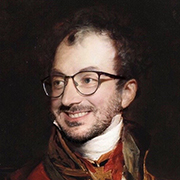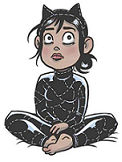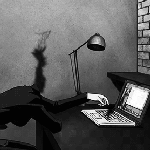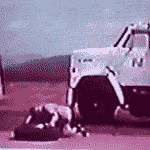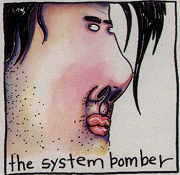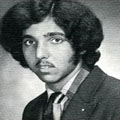|
Following a discussion in the PYF historical fun fact thread, we thought there might be space between a "PYF funny pictures" and a "PYF mildly interesting pictures" thread for a thread dedicated to cool old photos and pictures, depicting both well-known and obscure stuff from yesteryear (they still are allowed to be funny and/or mildly interesting, though!). A Bosnian girl waits for a funeral service to commence (Sarajevo, 1992)  Carriages amass in front of St Peter's cathedral for a public papal audience (Rome, 1860)  English-German flyer calling for Chicago-based workers to arm themselves and gather at a rally which would later escalate into a shootout known as the "Haymarket massacre" (Chicago, 1887)  Archbishop José Maria Yerovi of Quito, Ecuador, two years after his death. Pope Pius IX appointed him archbishop before the news of Yerovi's death had reached Rome, so the pope ordered him to be dug up and properly invested with the pallium, i.e. the sign of being an archbishop (Quito, 1869)  The stern-looking woman to the very left maybe is none other than Constanze Mozart (1762-1842), wife of legendary composer Wolfgang Amadeus Mozart who had died in 1791 (Altötting, 1840?)  Winston Churchill, his son and his grandson all dressed up for the coronation of Queen Elizabeth II (London, 1953 (colourised))  A guy getting pantsed (Luttrell Psalter, c.1320-1340, England) https://www.youtube.com/watch?v=qPzyJxwcWpE What are videos, if not a lot of photos quickly shown consecutively?  Funeral procession of Austrian-Hungarian emperor Francis Joseph who had ruled his realm for 68 long years (Vienna, 1916) Funeral procession of Austrian-Hungarian emperor Francis Joseph who had ruled his realm for 68 long years (Vienna, 1916)There is an absolute wealth of easily available historical photos and pictures nowadays. Some starters: the "History Porn" and the "History in Color" subreddits, the LIFE photo archive and the Europeana collections. But again, there is a fuckton of other databases and collections, so delve into the wonderful world of historical iconography and photography and show us your best finds!
|
|
|
|

|
| # ? Apr 27, 2024 17:58 |
|
System Metternich posted:
It is worth mentioning that the Haymarket Massacre ( https://en.wikipedia.org/wiki/Haymarket_affair ) is why we have the International Worker's Day (May 1st). To contribute here is one of the earliest Norwegian photographs, showing the Royal Castle in Oslo somewhere between 1840 - 46. 
|
|
|
 Walter Rothschild riding his giant tortoise
|
|
|
|
|
Just gonna repost the thing I posted in the other thread that inspired this threadCatboy Autonomist posted:
|
|
|
|
Ooh I get to talk about one of my favorite photographers. Sergey Prokudin-Gorskii was a Russian photographer and a pioneer in the world of color photography at the turn of the 20th century. His work captured the attention of Tsar Nicholas II and in return was granted a commission documenting the frontiers of the Russian Empire. From 1909 to 1915, Prokudin-Gorskii travelled the empire documenting it's many places and inhabitants. Originally slated to be a 10 year project, it had to be put on the shelf due to the outbreak of the Bolshevik Revolution (and his benefactor getting riddled with bullet holes shortly after). Today most of his work during this period is preserved in the Library of Congress.     
|
|
|
|
Alhazred posted:
 And here he is sitting in his zebra-drawn carriage Speaking of animals:  This is the "Lion of Gripsholm" in Sweden. Doesn't look so bad, no? In 1731, King Frederick I got a lion as a gift from the Bey of Algiers, and when the animal died he gave its remains to a taxidermist so that it would continue to adorn his royal halls. The problem (at least as the story goes) was: the taxidermist hadn't been able to see the animal while alive, so he did the best he could and recreated it as a heraldic lion - and he did a good job! If you make the mistake and look at the animal from any other angle, however...  ...well, it doesn't look so grand anymore!  Government Handjob posted:It is worth mentioning that the Haymarket Massacre ( https://en.wikipedia.org/wiki/Haymarket_affair ) is why we have the International Worker's Day (May 1st). Very cool! Going southwards (and paging Krankenstyle to this thread), this appears to be the earliest photograph made in Denmark, showing Ulfeldts Plads in Copenhagen, probably around June 1840:  There is even a person visible! If you look closely, there is a guy sleeping at the foot of the statue which is why the long exposure didn't fail to catch him.  It's surprisingly hard to find any one photo that's considered to be "the oldest" in Germany (and the possible photograph of Constanze Mozart from 1840 isn't exactly commonly accepted as such), so maybe this will suffice: Hermann Biow (1804?-1850) was one of the earlist daguerrotypists in Germany and took a couple of photos of Hamburg after the big fire of 1842. They belong to the oldest examples of journalistic photography ever. And as a last picture:  I took this out of a book with my phone camera, so excuse the mediocre quality. This is Franz Götzfried (1822-1915), the last messenger employed by the Catholic dean of Kirchheim, southwest of Augsburg. I can only dream of ever being half as cool as this guy
|
|
|
|
Franz Reichelt, testing his prototype parachute by jumping off the Eiffel Tower. Unfortunately it was more of a plummet.  It ended poorly (RIP). 
|
|
|
|
System Metternich posted:
similarly, you can see a shoe shiner in one of the first photos taken by Louis Daguerre  One of my favorite historical photos is this one  It's a photo of all the delegates of the british north american colonies or as it was known later, Canada. Everyone in this photo was hungover as hell. The fellow sitting down in the center would be the first prime minister of canada, John A. Macdonald and was also known as a notorious alcoholic. He was said to be too hungover to even stand for the photo.
|
|
|
|
I helped spur on this thread. So I should probably post something. I've been watching The Man in the High castle recently and it got me researching about American Nazis during WW2.  This is the German American Bund Rally at Madison Square Garden on February 20, 1939. There were approximately 20,000 people in attendance. This link has more photos from that event, the protests outside, and various other American Nazi activities of the time: https://www.theatlantic.com/photo/2017/06/american-nazis-in-the-1930sthe-german-american-bund/529185/
|
|
|
|
System Metternich posted:Very cool! Going southwards (and paging Krankenstyle to this thread), this appears to be the earliest photograph made in Denmark, showing Ulfeldts Plads in Copenhagen, probably around June 1840:  Copenhagen City Archives, City Museum, and Frederiksberg City Archives have been digitizing a huge pile of photographs. They're being indexed with keywords and geolocations by volunteers. Super cool stuff. https://kbhbilleder.dk  "Hospital welfare recipients" from Almindeligt Hospital (the commoners' hospital), 1890s0 https://kbhbilleder.dk/kbh-museum/82991  Same. https://kbhbilleder.dk/kbh-museum/82989 I'm guessing the one guy has shoe-shining stuff to demonstrate their value to society?
|
|
|
|
Lord Lambeth posted:similarly, you can see a shoe shiner in one of the first photos taken by Louis Daguerre The first ever human to be photographed, no less.
|
|
|
|
Eugen Sandow was the first bodybuilder to appear on film. He was filmed by Thomas Edison himself. Edison and Sandow. 
|
|
|
|
Reminds me of this beauty contest for men in 1909, at the men's section of the public baths Helgoland in Copenhagen. https://kbhbilleder.dk/kbh-museum/84195 https://kbhbilleder.dk/kbh-museum/84195lol at the kinda dumpy guy in the middle. There's a quotation attached, "They aren't exactly all beauties etc. [sic]" attributed to Helen of Troy, I don't know the "official" English translation, or even what work it's from. Carthag Tuek has a new favorite as of 05:49 on Sep 3, 2018 |
|
|
|
I'm having some difficulties pulling images from this site, so I will just link it. I recently rediscovered this curated archive from The New York Times. It has some gems. http://livelymorgue.tumblr.com/about
|
|
|
|
Say Nothing posted:Eugen Sandow was the first bodybuilder to appear on film. He was filmed by Thomas Edison himself. Wow, I thought he was just someone made up for the Venture Bros.
|
|
|
|
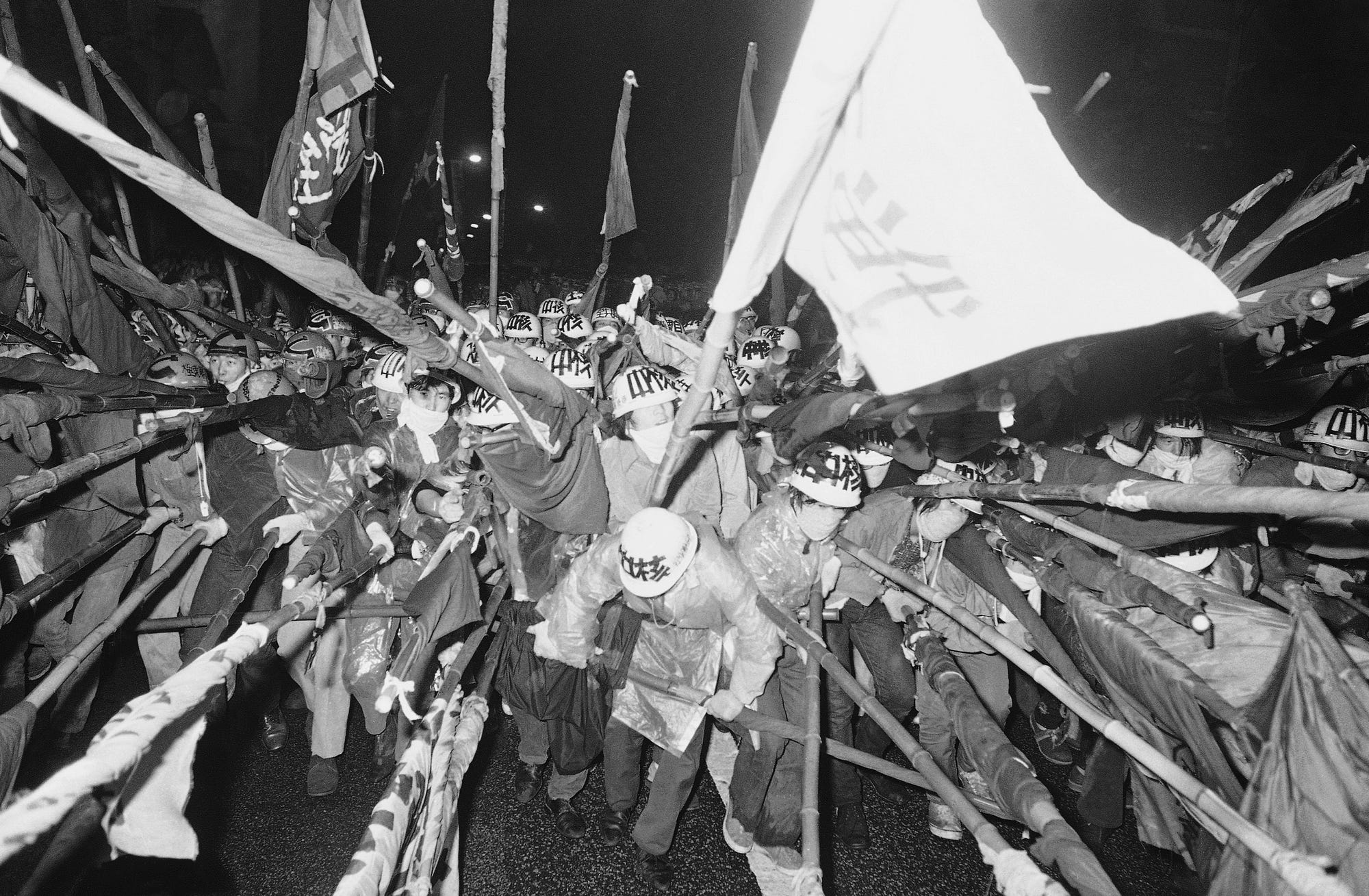 Zengakuren-affiliated protesters (an umbrella term for the various factions of Japan's leftist student organizations) charging at a protest in 1971 against the terms of the handover of control of Okinawa from the US to Japan Also, here's a Zengakuren guy with a cat 
|
|
|
|
ExplodingSims posted:Wow, I thought he was just someone made up for the Venture Bros. I’m phone posting, please pretend I put some Klaus Nomi photos here.
|
|
|
|
Ommin posted:I'm having some difficulties pulling images from this site, so I will just link it. I recently rediscovered this curated archive from The New York Times. It has some gems. That's really cool! I'ts possible to pull the pictures by using Firefox, at least; I right-click them, choose "show picture information" and then choose again the .jpg depicting the front side. It's a bit cumbersome, but it works perfectly!   quote:Sept. 1, 1915: “Germans lately do not capture a number of Frenchmen but they succeeded to capture five warlike French dogs,” read a curiously light caption accompanying this photo, taken while a world war was raging. “The dogs however, do not feel very cross with their captors.” Photo: The New York Times I've also just noticed that Associated Press has started putting videos from their vast film archive on youtube, with lots of fascinating stuff in there. https://www.youtube.com/watch?v=gUegeOYm2wU Installation of Pope John Paul I, exactly 40 years ago. He would die a sudden and unexpected (and amny would say: suspicious) death only 25 days later https://www.youtube.com/watch?v=njFAoTYi7XE Super male-gazey British newsreel from 1974 about women's football in Germany.  for two lady streakers appearing for a couple of seconds, I guess for two lady streakers appearing for a couple of seconds, I guess
|
|
|
|
In 1863, the Japanese Emperor attempted to try and close or at least limit Japanese contact with the West after Commodore Perry's visit. Part of this involved sending a delegation to France. On the way over, they decided to stop off for some sightseeing: 
|
|
|
|
Tallest boxer ever, Gogea Mitu. 7'7" (he's the one on the left).
|
|
|
|
Did he win by default because his opponents could only hit him beneath the belt? Or did he just beat the tar out of everyone he faced? Good photo either way.
|
|
|
|
Ultimate Mango posted:Did he win by default because his opponents could only hit him beneath the belt? Seriouspost: with people like that you just have to wait five years for them to die of heart failure or become cripples. e: Oh, didn't take him five years 
|
|
|
|

|
|
|
|
Short and to the point, I see  I posted some imo really fascinating photos of a Peruvian village in the 1960s along with the corresponding backstory in the old Christianity thread over in A/T some time ago, might as well repost it here now that the original thread is closed: By chance I stumbled upon a digital collection of gorgeous photos today that depict a bygone time of a very foreign (to Western eyes, that is) variety of syncretised Catholicism, but also gives fascinating insights into how the Catholic Church succeeded and failed in the specific context of 20th century Peru. Chuschi is a small village of maybe 1,300 people deep in the Peruvian Andes at an elevation of about 11,000 feet, situated right in the middle of the province of Cangallo where even nowadays the vast majority of people speak a Quechua dialect instead of Spanish. Back in the late 60s, an American anthropologist called Billie Jean Isbell spent a long time in the village community and observed both its daily life and its varied rituals, taking lots of photos in the progress. Here are some of the 1967 Corpus Christi celebration:   There was a procession, of course, where figures of various saints were paraded through the village as part of elaborate floats which were built by the mayordomos, i.e. local elites who also organised the entire fiesta. The procession wasn't the most important part of the ritual, at least not for the villagers. What really was at the centre for them was the invasion of the sallqaruna, the "savage people". The sallqaruna were llama herders who lived permanently in the puna grasslands of the high Central Andes, even higher than the village itself. They were neither regarded as a different caste nor a different ethnicity by the villagers, but due to their geographical isolation they were regarded with suspicion at best and open hostility at worst, and many people in the village believed them to be were-llamas, a shameful condition created by unbecoming sexual conduct.   The central part of the ceremony was the ritual invasion of Chuschi by villagers diguised as sallqaruna. In the upper image you see a little boy playing the part of a sallqaruna, riding on horseback into the village; the other picture shows the ritual descent from the puna of the whole group.  Part of the play was the sounding of the alarm, when villagers blew their waqarapuku. There are no more (good) photos of the ceremony, but after the arrival of the sallqaruna it also involved the "savage men" ritually despoiling a statue of the Blessed Virgin, their being "chased off" and a bullfight. There is also another wonderful photo of a funeral ceremony I wanted to show you:  The important thing here is that this is not a priest, but a "simple" villager conducting the funeral rites, albeit one who had been identified by the community as a religious specialist. In this shot you can see him carrying a cross and sprinkling the funeral bier with holy water; Isabell tells us that he was reciting "Latin" prayers during that time, or at least prayers in a language that was supposed to approximate actual Latin (the square quotes were used by Isabell herself). Why now a layman and not an ordained priest? Well, this has a twofold story behind it: on the one hand, this probably represents a surviving remnant of pre-Columbian funeral rites in which the priest isn't actually supposed to play a part. On the other hand, Chuschi was and is situated in the Archdioce of Ayacucho which used to be regarded as the most Catholic part of Peru, but also the diocese with the most conservative clergy. While other dioceses in Peru picked up liberation theology and its predecessors at an early date and put a lot of effort into caring for the poor and downtrodden, especially in rural regions like the Andes, the clergy of Ayacucho continued to display an almost colonial mindset, where priests mostly came from Spanish or at least mestizo background and represented the social, ethnic and economic elite with little regard for the worries of their flock. In the specific case of Chuschi, at the time the photo was taken the parish was administered by Father Chávez, a priest who originally hailed from the coastal Áncash region and came to the village in 1963. Like his predecessors, Father Chávez enjoyed the benefits of his office in the form of 100 acres of the best land and a large herd of 800 livestock cared for free of charge by the villagers. Even though by the standards of the time and region this made him a very wealthy man, he also charged the villagers for basically everything: Baptising children? Money, please. Performing a wedding? You better believe that'll cost you. He read up to three Masses a day, each one lasting a whopping five to eight minutes (!) and charged the villagers through the nose for each one of them. Even the accessories you can see in the photo above - the cross, the aspergillum, the bier and even the black cloth - had to be rented from the priest for a fee. No wonder that the villagers wanted to minimise Father Chávez' involvement! Small wonder too, that in a region where a priest conducting himself like this was sadly not the exception but the rule, a great deal of resentment quickly grew. It is no coincidence that it was Chuschi where in 1980 the maoist insurgency known as the "Shining Path" began its decades-long bloody war with the state that left tens of thousands dead, and that it was the region of Ayacucho where the fighting was the heaviest. While in other parts of Peru, the clergy would denounce all violence on both sides, both by the Shining Path and the military government (sometimes at great personal danger), the Ayacuchan clergy would instead throw its weight fully behind the local government even though everybody knew that its death squads were at least as violent and brutal against the peasants as the Shining Path insurgents were (Chuschi itself suffered from that, when in 1991 government militias beat up and arrested four villagers charged with harbouring maoist sympathies. None of them were ever seen again). Father Chávez wasn't part of that, however. After a while the conflict between him and his flock had grown so bad (not only because of financial arguments, but also because of allegations of general bad conduct levied against him, ranging from public drunkenness to physical violence against his subordinates and even rape), that in 1971 the village petitioned the archbishop for Father Chávez' immediate removal. After the archbishop refused that request, the villagers instead occupied all ecclesiastical grounds and buildings, took over the priest's livestock and unceremoniously forced him to leave the village. No successor priest was able to establish himself, and to this day Chuschi doesn't have a resident priest, relying instead on itinerant priests to perform various rites and doing the rest by themselves. It isn't unique in this regard, however: many other parishes within the Archdiocese of Ayacucho also lost their priests, both due to a lack in vocations and after similar altercations as in Chuschi, and either turned towards evangelical Pentecostalism or created their own, independent version of folk Catholicism that largely has no need for Church hierarchy anymore. If the archdiocese wanted to address that or maybe even stop that development, then it needed to honestly confront its own shady past. There is no sign that it wants to do that, however; instead the former archbishop of Ayacucho and apologist for governmental violence got made cardinal-archbishop of Lima and refuses to even talk about the Shining Path years. Literature:
|
|
|
|
 I also got a lot of living history photos, which I hope you will enjoy A mourner at the funeral of Sir William Johnson  Eighteenth-century ballet dancers  Action shot  Louis XIV, the Sun King, in costume for a ballet  Sure I'll have some more later.
|
|
|
|
That dog totally looks guilty for knocking that pitcher over. Also the collar around the neck has just always been the standard, huh?
|
|
|
|
Great thread! My old one died in its infancy. https://rarehistoricalphotos.com has a lot of good stuff too, along with some interesting (albeit short) write-ups accompanying the pictures. The pic of Archbishop José Maria Yerovi makes me really uncomfortable. I really hope that wasn't publicized at the time. Do you have any more information on what happened with that? Some googling brings up things in Spanish, so I couldn't get really far. Christ almighty that is some really morbid stuff.
|
|
|
|
buglord posted:Great thread! My old one died in its infancy. https://rarehistoricalphotos.com has a lot of good stuff too, along with some interesting (albeit short) write-ups accompanying the pictures. At the time, photography of the dead was done to make a 'last look' possible. Thanatos.com has an excellent selection, though be forewarned: the majority are of young children, dead from the same diseases anti-vaxxers want to return. Exhuming a body for a ritual of some kind was not unknown. People were exhumed to be executed, like Cromwell. If you were considered holy, you might be exhumed to see if you were an Incorruptable--ie, perfectly preserved--and thus eligible for sainthood. Inez de Castro, wife of King Pedro of Portugal, was exhumed so she could be crowned. She had been murdered, which set off a terrible war; once peace was restored, the victorious Pedro ordered her to be dressed as queen and placed on her throne. All members of the court had to bow and kiss the ring on her hand.
|
|
|
|
Khazar-khum posted:At the time, photography of the dead was done to make a 'last look' possible. Thanatos.com has an excellent selection, though be forewarned: the majority are of young children, dead from the same diseases anti-vaxxers want to return. The bishop looks like the accused Pope in the painting of the Cadaver Synod.
|
|
|
|
buglord posted:Great thread! My old one died in its infancy. https://rarehistoricalphotos.com has a lot of good stuff too, along with some interesting (albeit short) write-ups accompanying the pictures. quote:To comply with [the papal] disposition, on March 5, 1869, almost two years after his death, José Ignacio Checa y Barba proceeded to exhume the body of Yerovi, who with great pomp was placed in the Cathedral, seated in an armchair, invested with vestments and pontifical insignia. Miraculously and to the delight of the Catholic Church and all the faithful, the corpse still maintained its flexibility and there was no sign of decomposition in it. It was a different time, simply put. Death was no stranger, and if I had to venture a guess I would say that most people would have seen plenty of dead bodies in their lives. Add to this a certain Catholic fascination with death as well as a lack of decomposition being regarded as a surefire sign of holiness, and it becomes clear that there was nothing morbid about that for people, but it was instead a sign of Christian triumph over death as well as a symbol that Yerovi would continue to exercise his episcopal office after death by way of intercession (which, going by Catholic theology, means that the dead shall ask God to favour the living). I found something interesting on Twitter today:  That's a weird mound in the middle of Mexico, photographed sometime during the late 19th century. What could have caused this curious geological formation?  This is what was beneath: the Pyramid of the Sun in Teotihuacan, a 1,900 years old structure erected by the Teotihuacan people which was given its current name by the Aztecs centuries later. It is the third-largest pyramid in the world. I wonder if the local peasants had any idea about what might be hidden under the earth?
|
|
|
|
Can someone post the dude eating rice and making the
|
|
|
|
System Metternich posted:Short and to the point, I see This is a fascinating post, thank you a lot. I might check out the links you posted at the end later as well.
|
|
|
|
TheBigAristotle posted:Can someone post the dude eating rice and making the Here you go: 
|
|
|
|
Catboy Autonomist posted:Here you go: 
|
|
|
|
I love this thread idea and hope it grows like the other Historical ones  I've always had a fascination with old pics from Chicago (my home town). Skid Row - Madison St. 1973: 
|
|
|
|
Khazar-khum posted:At the time, photography of the dead was done to make a 'last look' possible. Thanatos.com has an excellent selection, though be forewarned: the majority are of young children, dead from the same diseases anti-vaxxers want to return. Zopotantor posted:The bishop looks like the accused Pope in the painting of the Cadaver Synod. System Metternich posted:It was a different time, simply put. Death was no stranger, and if I had to venture a guess I would say that most people would have seen plenty of dead bodies in their lives. Add to this a certain Catholic fascination with death as well as a lack of decomposition being regarded as a surefire sign of holiness, and it becomes clear that there was nothing morbid about that for people, but it was instead a sign of Christian triumph over death as well as a symbol that Yerovi would continue to exercise his episcopal office after death by way of intercession (which, going by Catholic theology, means that the dead shall ask God to favour the living).
|
|
|
|
Some vintage sexy - Betty Page.
|
|
|
|
I saw these two pics in close proximity to each other a while back and couldn’t stop imagining the buddy-cop movie.
|
|
|
|
Lazlo Nibble posted:I saw these two pics in close proximity to each other a while back and couldn’t stop imagining the buddy-cop movie. 
|
|
|
|

|
| # ? Apr 27, 2024 17:58 |
|
buglord posted:Site you linked doesn't lead me anywhere. Would like to see it though! I didn't know people were put on trial or had their statuses amended post-death. Growing up catholic, I knew people could become saints after their death, but I didn't know that they were historically dug up as a way of verifying sainthood. My bad. http://thanatos.net/ Most are of very small children. For the most part there's nothing gross or horrifying, though there's a few that are bad. The medical images archive has loads of dissection pictures, which can be very creepy. There's a bit out there about the Incorruptables. The Church now allows for the preservation of the body because once it's been exposed to air, decay will often set in. Most are clearly some form of natural mummy, though why a body in one grave would mummify while the one next to it doesn't is an open question. Some of them, though, just look like a sleeping person, even though they died in the 17th century. It's part of Catholicism they don't really teach in catechism. Seeing the grand reliqueries in Spanish cathedrals really reignited my faith.
|
|
|



